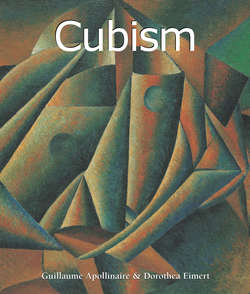Читать книгу Cubism - Guillaume Apollinaire - Страница 8
На сайте Литреса книга снята с продажи.
II. What Is Cubism?
Simultaneity in Cubist Circles
ОглавлениеIn 1913, the poet Guillaume Apollinaire dedicated his work The Cubist Painters to Cubism, thereby helping the movement attain broad renown. Painters like Jean Metzinger and Albert Gleizes made impressive contributions to the Cubist language of shapes. In 1912 one of the most famous paintings of the 20th century was created: the Nude Descending a Staircase (No. 2) by Marcel Duchamp. Aided by the Cubist vocabulary of shapes and his familiarity with Étienne-Jules Marey’s photos depicting movement, Duchamp painted a picture that moved the world. Five moments of the movement of one person, descending a spiral staircase, are captured in time-lapsed sequence, showing all the reciprocal movements triggered by her walking. In doing this, Duchamp introduced time as the fourth dimension in the painting. Though this nude triggered a scandal at the famous 1913 Armory Show in New York, some recognised the innovative character of this new work, calling it “the light at the end of the tunnel”. Duchamp, brother of the painter Jacques Villon, the sculptor Raymond Duchamp-Villon and the painter Suzanne Duchamp, was anything but a consistent worker. His unruly soul quickly led him to experiment with different media and eclectic ideas that shocked the art world. In New York, he became friends with Francis Picabia, with whom he became responsible for Dada.
Sonia Delaunay, Contrastes Simultanés (Simultaneous Contrasts), 1912.
Oil on canvas, 46 × 35 cm.
Simultaneity is the lyric expression of the modern view of life; it signifies the rapidity and the concurrence of all existence and action. Simultaneity for the Futurists was the “lyrical exultation [and] the artistic visualisation” of velocity. It is the result “of those great causes of universal dynamism.” Simultaneity was also the focus of Robert and Sonia Delaunay. However, they both interpreted the term in a completely different manner. When Guillaume Apollinaire credited both the Delaunays with the term, the Futurist Boccioni accused them of plagiarism, because he was not prepared to cede this key term to others, much less to two whose interpretation veered so greatly from his own.
The Delaunays did not, like other artists, use this term to mean dynamism. They did not refer to the “élan vital” (“vital force”) as Bergson did, but rather to Chevreul’s theory of the law of simultaneous contrast. This theory, which dated from 1839 and had already played a role with the Impressionists, related colours and the relationship of objects to one another. Chevreul’s work was republished in 1890 and thus more present in the collective knowledge of artists. Sonia Delaunay, in her work Contrastes Simultanés (Simultaneous Contrasts) dared to jump directly into the abstract. Her painting was already a formal reference system of colour rhythms at a time when her husband Robert and artists Klee, Kandinsky, Mondrian and Picasso were still slowly making their way towards detaching themselves from objects.
Robert Delaunay founded Orphism, also known as Orphic Cubism. On account of the orchestration of colour, Guillaume Apollinaire named Delaunay’s painting style after Orpheus, the singer of Greek mythology. The origins of his painting style derived from Impressionism, Analytical Cubism and from Cézanne. The new landmark of Paris, the Eiffel Tower, built in 1898, fascinated him. Its elegant design became the subject of the Windows series. He painted it again and again, in new variations and refractions, using light and bright colour harmonies based on the colour values of light separated by a prism. Emphasising the delicate construction, he ceaselessly offered new perspectives of the monument, showing it in new lights and refractions, and always from a different viewpoint.
Sonia Delaunay, Electric Prisms, 1914.
Oil on canvas, 250 × 250 cm.
Musée National d’Art Moderne, Centre Georges-Pompidou, Paris.
